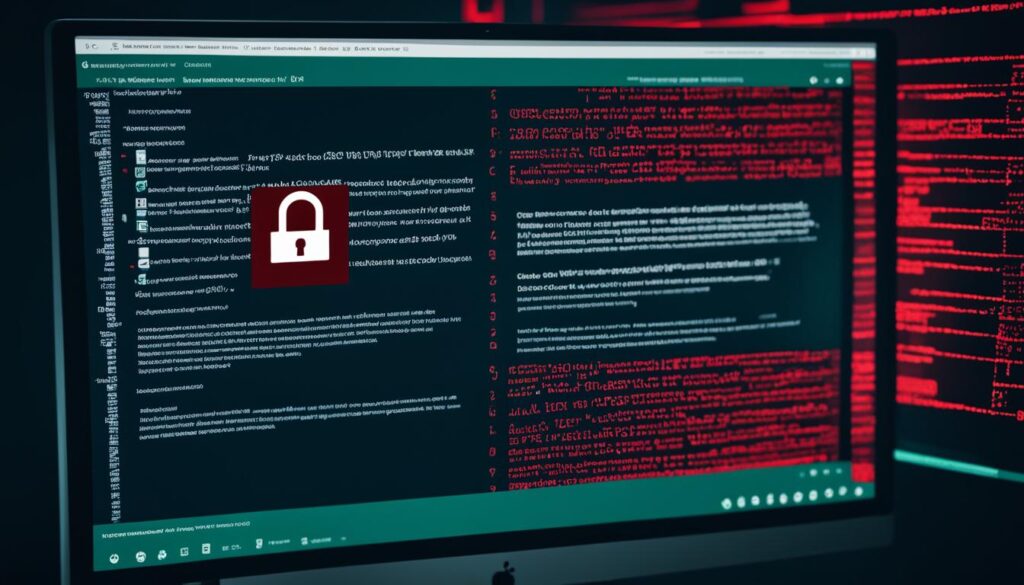Understanding the types of cyberattacks and how to prevent them is crucial in today’s digital age. With cybercriminals becoming increasingly sophisticated, it is important for individuals and organizations to be aware of the common threats and employ effective cybersecurity measures. By implementing proper prevention strategies, everyone can protect themselves against cyber threats and ensure the safety of their sensitive information.
The motives behind cyberattacks vary, ranging from financial gain to disruption, vandalism, and espionage. According to Check Point Research, the average organization experienced 1,158 attacks worldwide in 2023. Additionally, Cybersecurity Ventures predicts that the global cost of cybercrime will reach a staggering $8 trillion in 2023. The impacts of cybercrime go beyond direct financial losses and can result in reputation damage and loss of customer trust.
In this article, we will explore some of the most common types of cyberattacks and provide prevention tactics to help individuals and organizations safeguard against these threats. From preventing data breaches to protecting against malware and employing robust cyber defense techniques, we will cover essential cybersecurity measures and best practices.
Key Takeaways:
- Understanding the types of cyberattacks is crucial for effective prevention strategies.
- Common cyber threats include malware attacks, ransomware attacks, password attacks, phishing attacks, and denial-of-service attacks.
- Implementing cybersecurity measures such as regular software updates, data backup, and user awareness training is crucial for preventing data breaches.
- Protecting against malware requires the use of antivirus software and practicing internet security best practices.
- Password security and user education play a vital role in preventing password attacks.
Malware Attack
Malware is a type of malicious software designed to exploit devices and benefit attackers. It poses a significant threat to individuals and organizations, compromising data security and privacy. Understanding the various types of malware is essential in implementing effective cybersecurity measures to protect against potential attacks.
Ransomware
Ransomware is one of the most feared forms of malware. It encrypts files on infected devices and demands a ransom payment from the victim to regain access to their data. Payment does not guarantee file recovery, and the victims often suffer financial losses and disruption to their operations. WannaCry, a notorious ransomware attack that affected organizations in over 150 countries, serves as a stark reminder of the devastating impact of such attacks.
Rootkits
Rootkits are malicious software that conceal their presence on a device by providing unauthorized access to attackers. These stealthy software packages seek to exploit vulnerabilities and create backdoors, allowing remote access and control of infected devices. Rootkits can facilitate further malware installation, data theft, or surveillance.
Trojans
Trojans are malware that masquerades as harmless programs, tricking victims into executing them. Once inside a system, Trojans can provide unauthorized access to cybercriminals, compromising sensitive data and enabling further malicious activities. These deceptive programs often spread through deceptive email attachments and software downloads, posing an ongoing threat to individuals and organizations.
Spyware
Spyware is designed to secretly monitor and collect information about a user’s activities without their consent. Cybercriminals use spyware to steal sensitive data, such as passwords, credit card numbers, and personal information. This type of malware is often distributed through malicious websites, freeware, or email attachments.
To protect against malware attacks, individuals and organizations should implement comprehensive cybersecurity measures. This includes using reliable antivirus software, regularly updating operating systems and applications, exercising caution when downloading files or clicking on links, and educating users about the risks of phishing and suspicious online activities.

Ransomware Attack
Ransomware attacks have become one of the most prevalent and damaging forms of cyber threats in recent years. This type of attack involves malicious software that encrypts important files on a victim’s computer or network, rendering them inaccessible. The attackers then demand a ransom payment in exchange for the decryption key, holding the victim’s data hostage.
It is important to note that paying the ransom does not guarantee that the files will be recovered. In fact, there have been instances where victims have paid the ransom, only to find that their files remain encrypted or permanently lost. This highlights the untrustworthiness of cybercriminals and the risks associated with giving in to their demands.
One of the most infamous ransomware attacks in history is the WannaCry attack that occurred in 2017. This large-scale attack targeted organizations in over 150 countries, infecting hundreds of thousands of computers. The impact of WannaCry was catastrophic, causing severe disruptions and financial losses for numerous businesses and institutions.

Notable Ransomware Attacks:
| Attack | Year | Global Impact |
|---|---|---|
| WannaCry | 2017 | Organizations in over 150 countries affected |
| MGM Resorts International | 2020 | Estimated $100 million in losses |
These high-profile attacks serve as a stark reminder of the devastating consequences that ransomware attacks can have on organizations. The financial losses incurred, coupled with the reputational damage and loss of customer trust, can be extremely difficult to recover from.
Prevention is key when it comes to mitigating the risk of a ransomware attack. Implementing the following prevention measures can significantly enhance an organization’s resilience:
- Regular software updates: Keep all operating systems and software up to date with the latest security patches to address vulnerabilities that cybercriminals may exploit.
- Data backup: Regularly back up important files and ensure that the backups are stored securely, offline or in the cloud, to prevent them from being encrypted in a ransomware attack.
- User awareness training: Educate employees about the risks of ransomware and the importance of practicing good cybersecurity habits, such as being cautious of suspicious emails and avoiding clicking on unknown links or downloading attachments from untrusted sources.
By implementing these prevention measures, organizations can significantly reduce their vulnerability to ransomware attacks and protect their valuable data from falling into the wrong hands.
Password Attack
Password attacks are one of the most common methods used by hackers to gain unauthorized access to user accounts. Understanding the different types of password attacks and implementing strong password security measures is essential in safeguarding your online presence.
Types of Password Attacks
Brute-force attack: In a brute-force attack, hackers systematically attempt all possible combinations of characters to guess a password. This method can be time-consuming but can eventually crack weak passwords.
Dictionary attack: A dictionary attack involves using a preselected list of commonly used words, phrases, or passwords to guess a user’s password. Hackers leverage the predictability of human behavior and common patterns to exploit weak passwords.
Social engineering: Social engineering is a psychological manipulation technique where attackers trick individuals into revealing their passwords. This can be done through various means, such as phishing emails or phone calls, where the attacker uses deception to gain the victim’s trust and obtain their login credentials.
Preventing Password Attacks
To protect yourself from password attacks, it is crucial to implement strong password security practices. Here are some essential tips:
- Create strong passwords: Use a combination of letters (upper and lower case), numbers, and special characters to create a unique and complex password. Avoid using easily guessable information, such as your name or birthdate.
- Enable multi-factor authentication (MFA): MFA adds an extra layer of security by requiring users to provide additional verification, such as a fingerprint scan or a one-time verification code, in addition to their password.
- Regular password updates: Change your passwords regularly to minimize the risk of compromised accounts. Aim to update your passwords every three to six months.
- Use a password manager: Password managers can securely store your passwords and help generate strong, unique passwords for each of your accounts.
- Stay vigilant against social engineering: Be cautious of suspicious emails, calls, or messages asking for your login credentials. Never provide your password or sensitive information to unverified sources.
By implementing these password security measures and staying alert to potential threats, you can greatly reduce the risk of falling victim to password attacks and protect your valuable personal information.
| Password Attack Method | Description |
|---|---|
| Brute-force attack | Systematically guessing passwords through trial and error |
| Dictionary attack | Using a preselected list of commonly used words or phrases to guess passwords |
| Social engineering | Manipulating individuals to reveal their passwords through deception |

Phishing Attack
Phishing attacks are a common cyber threat that relies on deceptive emails to trick users into revealing personal information. These emails often appear legitimate, imitating well-known brands or trusted individuals. Attackers may use email spoofing techniques to make the email appear to come from someone the victim knows and trusts. The goal of phishing attacks is to obtain sensitive information such as login credentials or to install malware on the victim’s device.
One of the key aspects of phishing attacks is social engineering, where attackers manipulate individuals through psychological manipulation and deception. By exploiting human emotions and trust, attackers can persuade victims to take actions that compromise their security.
Here are some important tips for detecting phishing attempts:
- Verify the email sender’s identity: Pay attention to the sender’s email address and look for any suspicious variations or inconsistencies.
- Avoid clicking suspicious links: Hover your mouse over links to preview the URL before clicking. Be cautious of URLs that don’t match the supposed source or include unusual characters.
- Be cautious with email attachments: Only open attachments from trusted sources. If you receive an unexpected attachment, verify its legitimacy with the sender before opening it.
Being vigilant and informed is crucial in protecting yourself against phishing attacks. By following these practices, you can minimize the risk of falling victim to these deceptive tactics.
| Common Signs of Phishing Emails | Examples |
|---|---|
| Urgent requests for personal information | “Your account will be suspended if you don’t update your password immediately. Click here to proceed.” |
| Inconsistencies in the email domain | “[email protected]” instead of “[email protected]” |
| Unusual grammar and spelling errors | “Important security alret: Problem with yuour acccount” |
| Suspicious attachments or links | “Click this link to claim your prize!” (from an unknown sender) |
| Requests for sensitive information via email | “We need your credit card details to confirm your recent purchase. Please reply with the information.” |
Remember:
Always be cautious and skeptical when receiving emails that ask for personal information or request urgent actions. Take the time to assess the validity of the email before providing any sensitive data.

Denial-of-Service Attack
A denial-of-service attack is a type of cyberattack that aims to overwhelm a website or network with excessive traffic, making it inaccessible to legitimate users. These attacks can have a severe impact on organizations, disrupting their operations and potentially causing financial losses.
Attackers often employ a technique known as Distributed Denial-of-Service (DDoS) to carry out these attacks. In a DDoS attack, multiple computers, often compromised by malware, flood the target with a massive amount of traffic, overwhelming its resources.
The impact of a denial-of-service attack can be significant. It can lead to prolonged periods of downtime, loss of potential revenue, damage to reputation, and even legal consequences. The time and effort required to recover from such an attack can be substantial, resulting in financial burdens for targeted organizations.
To prevent denial-of-service attacks, organizations should implement robust network defenses. This includes deploying firewalls, intrusion detection systems, and traffic filtering mechanisms to identify and block malicious traffic. Regular monitoring for suspicious traffic patterns is crucial for detecting and mitigating potential attacks.
Denial-of-Service Attack Prevention Measures
- Invest in robust network infrastructure to handle high volumes of traffic.
- Implement firewalls, intrusion detection systems, and traffic filtering mechanisms.
- Regularly update and patch software to address vulnerabilities that attackers could exploit.
- Utilize rate limiting and traffic shaping techniques to control network traffic.
- Establish incident response plans to mitigate the impact of an attack and quickly restore services.
- Engage third-party DDoS protection services for added security.
By taking proactive measures to protect against denial-of-service attacks, organizations can safeguard their networks and maintain uninterrupted availability for their users.
| Impact of Denial-of-Service Attacks | Prevention Measures |
|---|---|
| 1. Disruption of operations | 1. Invest in robust network infrastructure |
| 2. Financial losses | 2. Implement firewalls and intrusion detection systems |
| 3. Damage to reputation | 3. Regularly update and patch software |
| 4. Legal consequences | 4. Utilize rate limiting and traffic shaping techniques |
Conclusion
To effectively protect against cyber threats, it is essential to understand the types of cyberattacks and implement preventive measures. Organizations should prioritize cybersecurity best practices to safeguard their sensitive data and operations.
Investing in regular software updates is crucial as it helps to patch vulnerabilities and stay ahead of evolving threats. Employee training is equally important, as it educates staff members about potential risks, such as phishing attacks or social engineering tactics.
Additionally, implementing technologies like firewalls and encryption adds an extra layer of security to defend against cyberattacks. Firewalls can monitor incoming and outgoing traffic, while encryption helps in securing sensitive information.
By staying informed about the latest cyber threats and adopting security best practices, individuals and businesses can effectively protect themselves from cyberattacks. Cybersecurity is an ongoing process, and it requires constant vigilance and proactive measures to mitigate potential damages.
FAQ
What are the types of cyberattacks and how can they be prevented?
There are various types of cyberattacks, including malware attacks, ransomware attacks, password attacks, phishing attacks, and denial-of-service attacks. These attacks can be prevented by implementing cybersecurity measures such as regular software updates, user awareness training, strong password practices, email verification, and robust network defenses.
What is a malware attack?
A malware attack is a type of cyberattack where malicious software is used to exploit devices and benefit attackers. Examples of malware include ransomware, which encrypts files and demands a ransom, rootkits that open backdoors on devices, Trojans that masquerade as harmless programs, and spyware that monitors internet activity and steals sensitive information.
What is a ransomware attack?
A ransomware attack is a type of cyberattack where attackers encrypt important files and demand a ransom payment for their decryption. Notable ransomware attacks include WannaCry, which affected organizations in over 150 countries, and an attack on MGM Resorts International. Preventive measures against ransomware attacks include regular software updates, data backup, and user awareness training.
What is a password attack?
A password attack is a type of cyberattack that targets user credentials to gain unauthorized access. Common methods include brute-force attacks, where attackers use trial and error to guess passwords, dictionary attacks that use a preselected library of commonly used words, and social engineering, where attackers manipulate individuals to reveal their passwords. Strong password practices and user education are key to preventing such attacks.
What is a phishing attack?
A phishing attack is a type of cyberattack that relies on deceptive emails that appear legitimate to trick users into revealing personal information. Attackers may use email spoofing to impersonate someone the victim trusts. The goal is to obtain login credentials or install malware. Detecting phishing attempts requires verifying email senders, avoiding clicking suspicious links, and being cautious with email attachments.
What is a denial-of-service attack?
A denial-of-service attack is a cyberattack that overloads websites or networks with excessive traffic, rendering them inaccessible. Attackers can use distributed denial-of-service (DDoS) attacks, which involve multiple computers flooding the target with traffic. Denial-of-service attacks can disrupt operations and cost organizations time and money to recover. Prevention measures include implementing robust network defenses and monitoring for suspicious traffic patterns.
How can cyberattacks be prevented?
Understanding the types of cyberattacks and implementing preventive measures is crucial in safeguarding against cyber threats. Organizations should invest in cybersecurity measures such as regular software updates, employee training, and implementing technologies like firewalls and encryption. By staying informed and adopting security best practices, individuals and businesses can effectively defend against cyberattacks and mitigate potential damages.








